
The Bibron's toadlet or brown toadlet is a species of Australian ground-dwelling frog that, although having declined over much of its range, is widespread through most of New South Wales, Victoria, south-eastern Queensland, and eastern South Australia, including Kangaroo Island. Bibron's toadlet settles in a wide variety of habitats within these region but they mainly reside in dry forests, woodland, shrubland, grassland, coastal swamps, heathland, and sub-alpine areas. They deposit their eggs in leaf litters during the flooding season, which is essential for the proper development of the egg. This species has high sexual dimorphism within the species and utilizes chemosignals to attract potential mates.

The dusky toadlet is a species of Australian ground-dwelling frog that inhabits coastal areas from just north of Sydney, New South Wales to mid-northern Queensland.
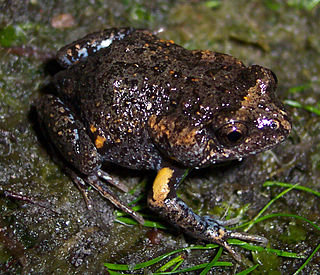
Tyler's toadlet is a species of ground frog that is found in coastal areas in southern New South Wales and eastern Victoria.

The dainty green tree frog, also known as the graceful tree frog, is a species of tree frog in the subfamily Pelodryadinae. It is native to eastern Queensland, and north-eastern New South Wales, Australia and ranges from northern Cape York in Queensland to Gosford in New South Wales, with a small and most likely introduced population in Hornsby Heights in Sydney. It is one of two faunal emblems of the City of Brisbane.
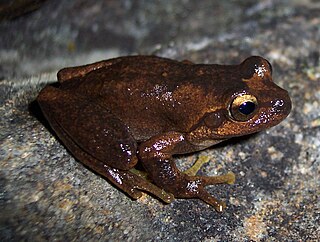
Littlejohn's tree frog, also called a heath frog or orange-bellied tree frog, is a species of tree frog native to eastern Australia from Wyong, New South Wales, to Buchan, Victoria.

The striped burrowing frog is a species of burrowing frog in the subfamily Pelodryadinae of the family Hylidae. It occurs throughout much of Australia, from northern New South Wales, through eastern and northern Queensland and into eastern Northern Territory. This species was once included in the genus Litoria or Cyclorana.
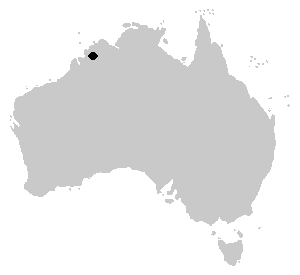
Uperoleia marmorata commonly known as the marbled toadlet, is only known by the holotype collected in the Kimberley region of Western Australia by Gray in 1841.

Ranoidea australis, commonly known as the giant frog, northern snapping frog, or round frog, is a burrowing species of frog native to Australia. It occurs from western Queensland through to northern Western Australia.

Metacrinia is a genus of frog in the family Myobatrachidae. It is monotypic, being represented by the single species, Metacrinia nichollsi, commonly known as the Forest toadlet or Nicholls toadlet. It is endemic to Southwest Australia, occurring between Dunsborough and Albany.

The large toadlet or great toadlet or major toadlet is a species of ground-dwelling frog native to eastern Queensland and northern New South Wales, Australia.
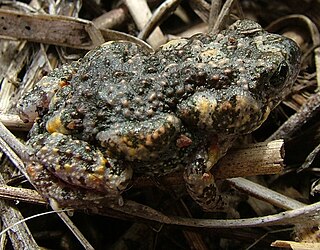
The wrinkled toadlet is a species of small, ground-dwelling frog in the family Myobatrachidae It is endemic to Australia. It is also commonly called the small-headed toadlet, red-groined toadlet or the chubby gungan.

The turquoise parrot is a species of parrot in the genus Neophema native to Eastern Australia, from southeastern Queensland, through New South Wales and into North-Eastern Victoria. It was described by George Shaw in 1792. A small lightly built parrot at around 20 cm (7.9 in) long and 40 g in weight, it exhibits sexual dimorphism. The male is predominantly green with more yellowish underparts and a bright turquoise blue face. Its wings are predominantly blue with red shoulders. The female is generally duller and paler, with a pale green breast and yellow belly, and lacks the red wing patch.
The tiny Pilbara toadlet ) is a species of frog in the family Myobatrachidae. It is endemic to the arid Pilbara region of Australia. It is a burrowing frog and is found in rocky gorges and creeks in the Pilbara following cyclonic rains. The species name saxatilis means "rock-dwelling".
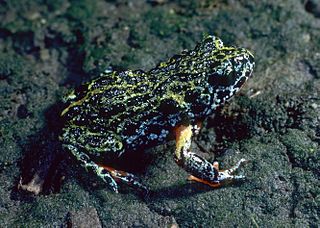
The southern toadlet, or marbled toadlet, is a species of small frog that is endemic to south-eastern Australia.
The Central Ranges toadlet, or Everard Ranges toadlet, is a species of small frog that is endemic to Australia.
The Howard Springs toadlet, also known as the Howard River toadlet, Davies's toadlet or the Darwin sandsheet frog, is a species of small frog that is endemic to Australia. The specific epithet daviesae honours Australian herpetologist Margaret M. Davies.
Mahony's toadlet is a species of small frog that is endemic to Australia. The specific epithet honours Professor Michael Mahony of the University of Newcastle for contributions to the study of Australian frogs.
The tiny toadlet is a species of small frog that is endemic to Australia. The specific epithet micra refers to its small size.
The ratcheting toadlet is a species of small frog that is endemic to Australia. The specific epithet stridera, as well as the common name, refer to the grating nature of the call.


















